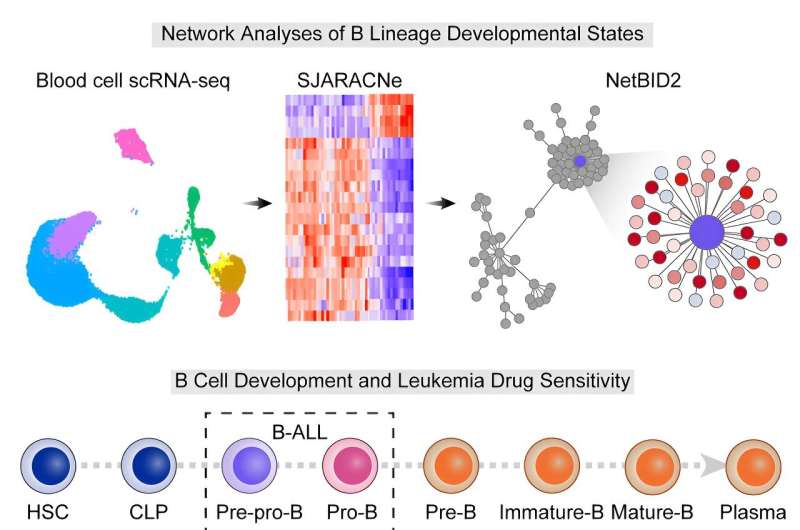This article has been reviewed according to Science X's editorial process and policies. Editors have highlighted the following attributes while ensuring the content's credibility:
fact-checked
peer-reviewed publication
trusted source
proofread
Targeting vulnerability in B-cell development leads to novel drug combination for leukemia

Despite having an overall survival rate of 94%, B-cell acute lymphoblastic leukemia (B-ALL), the most common childhood cancer, can prove challenging to treat, with survival among relapsed or resistant cases falling between 30-50%.
In recent work by St. Jude Children's Research Hospital, scientists discovered which tumor cells resist treatment and why. This enabled the rational design of a combination therapy that better controlled high-risk subtypes of B-ALL in mouse models. The findings were published today in Cancer Cell.
"We found a new explanation of B-ALL sensitivity to asparaginase, which is one of the most commonly used drugs for this disease," said senior co-corresponding author Jun J. Yang, Ph.D., St. Jude Department of Pharmacy and Pharmaceutical Sciences vice-chair. "Although asparaginase has been around for almost 50 years, the way we use this drug for ALL remains imprecise. This is partly because we still do not fully understand the mechanism by which it kills leukemia cells."
Scientists showed combining the classic drug asparaginase (chemotherapy) with a newer drug, venetoclax (a BCL-2 targeted therapy), was most effective at treating B-ALL in laboratory models. The combination reduced the number of leukemia cells more than either drug alone and worked faster. The improved effects were consistent across three different high-risk subtypes of this cancer.
"This discovery was enabled by single-cell systems biology analysis of B cell development and integration with B-ALL drug sensitivity profiling and bulk RNA-sequencing data," said co-corresponding author Jiyang Yu, Ph.D., St. Jude Department of Computational Biology interim chair. "Our single-cell network analysis revealed the protein BCL-2 as a hidden vulnerability in the asparaginase-resistant tumor developmental stage."
"Administering asparaginase alongside venetoclax may lower the risk of ALL relapse, the major reason for treatment failure," said co-author Ching-Hon Pui, MD, St. Jude Department of Oncology Fahad Nassar Al-Rashid Endowed Chair of Leukemia Research. "Ideally, we aim for venetoclax to potentiate the anti-leukemia properties of asparaginase while keeping its toxicity levels in check. These concepts warrant further investigation in future clinical trials."
Venetoclax is already Food and Drug Administration–approved for use in other pediatric cancers, making it an attractive candidate. The drug has proven safe in those settings, paving the way for future approval in B-ALL treatment. The largest hurdle was understanding how venetoclax works with asparaginase to stop B-cell leukemia.
B-cell development stage is a challenge and vulnerability in B-ALL
B-ALL is a cancer derived from white blood cells called B cells. Under normal circumstances, B cells develop from immature to fully mature, passing through eight steps. In cancers, cells can get stuck in an intermediate stage of development. In a related disease, T-cell acute lymphoblastic leukemia,
Yang and Yu previously found, as reported in Nature Cancer 2021, that the developmental stage where T cells get stuck determines their sensitivity to therapeutics. The researchers wanted to understand what made cells in a specific stage respond to which drug, hoping that such understanding would present new therapeutic opportunities.
"In this case, we found tumor B cells are stuck in two major stages," Yu said. "One is an earlier stage that is more resistant to asparaginase and another later stage that is more sensitive to it."
Yu looked at gene expression data from hundreds of thousands of individual cancerous B cells to understand what was different about them. After identifying the two dominant B-cell development stages of B-ALL, pre-pro-B (early) and pro-B (late), his lab looked for the genes upregulated in the resistant early cells to identify potential vulnerabilities to target therapeutically.
"The protein BCL-2 caught our attention, as it seems to be a driver of asparaginase-resistance in leukemia cells with pre-pro-B features," Yu said.
B cell lymphoma protein 2 (BCL-2) is a protein involved in cell death. Cancer cells use it to evade the systems that normally cause them to self-destruct. The protein is also downstream of mTOR, the protein targeted by asparaginase. Findings showed that BCL-2 was activated in cancer cells resistant to that drug. That resistance relationship motivated the scientists to try venetoclax, which targets the protein BCL-2, in a combination approach.
"When you add asparaginase, you hit mTOR signaling," Yang said. "In turn, that upregulates the BCL-2 activity, making the cells more sensitive to venetoclax."
The work also has implications for other cancers because incorrect development underlies many forms of the disease. Single-cell gene sequencing and analysis may provide similar opportunities to improve therapies in those contexts.
"We showed that developmental arrest of cancer cells can make them sensitive to certain drugs," Yang said. "Once we determine the pathways involved, we can find new drug combinations to improve treatment outcomes."
More information: Xin Huang et al, Single-cell systems pharmacology identifies development-driven drug response and combination therapy in B cell acute lymphoblastic leukemia, Cancer Cell (2024). DOI: 10.1016/j.ccell.2024.03.003




















